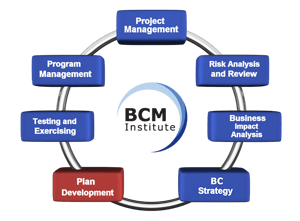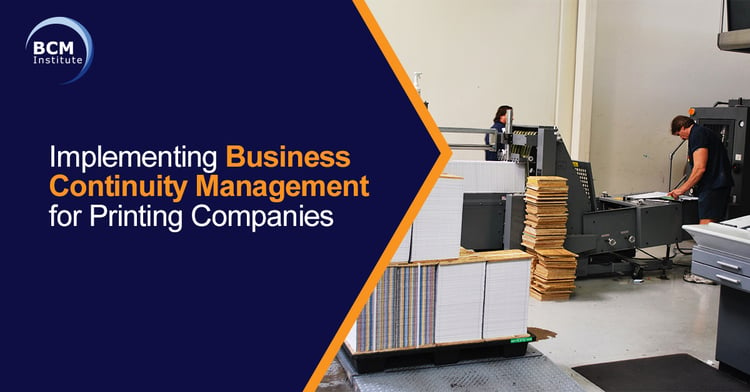What are the Key Steps Undertaken to Implement BCM for a Typical Printing Company?
Before the start of your Business Continuity Management (BCM) project, one of the initial key steps is to have a good "Understanding of Your Organisation: Printing Companies", in the context of business continuity management.
What is Business Continuity Management?
 According to the ISO 22301 BCMS Standard, Business Continuity Management (Goh, 2015), or BCM is a “Holistic management process that identifies potential threats to an organization and the impacts to business operations those threats.
According to the ISO 22301 BCMS Standard, Business Continuity Management (Goh, 2015), or BCM is a “Holistic management process that identifies potential threats to an organization and the impacts to business operations those threats.
If realized, might cause, and which provides a framework for building organizational resilience with the capability for an effective response that safeguards the interests of its key stakeholders, reputation, brand and value-creating activities."
This definition can be simplified as an organization-wide discipline and a complete set of processes that identifies potential impacts which threaten a printing company. It provides a capability for an effective response that safeguards the interests of its major stakeholders and reputation.
What is BCM for Printing Companies?
 In the context of printing companies, business continuity management is a complete set of processes that identifies potential impacts which threaten the printing companies as well as various aspects that the the entire printing operations, which is:
In the context of printing companies, business continuity management is a complete set of processes that identifies potential impacts which threaten the printing companies as well as various aspects that the the entire printing operations, which is:
- Pre-press
- Press or Output
- Post-press or Finishing
It allows a printing company, as an organisation, to be equipped in protecting its reputation and dealing with any incoming threats that may hinder its ability to perform its various daily printing assignments.
BCM Planning Methodology
 Printing companies, large or small, are vulnerable to disruptions and threats. Any incident, if not managed properly, can escalate to become a disaster or crisis, or even cause significant injuries to employees or even death. Therefore, a printing company should be prepared for an incident before it occurs to minimize its impact should it happen. One such way to prepare is to adopt a BCM Planning Methodology.
Printing companies, large or small, are vulnerable to disruptions and threats. Any incident, if not managed properly, can escalate to become a disaster or crisis, or even cause significant injuries to employees or even death. Therefore, a printing company should be prepared for an incident before it occurs to minimize its impact should it happen. One such way to prepare is to adopt a BCM Planning Methodology.
The BCM planning methodology, like any other planning process, provides a framework for requirements, effort, and deliverables, each phase leading into the next in an endlessly repeating cycle. The BCM Planning Methodology (Goh, 2015) is divided into the various steps. The key is to divide the entire process such that it is manageable.
Risk Analysis and Review [RAR]
Within the context of a Printing Companies, a wide array of risks, can be identified. One possible risk scenario is the loss of an office building or IT systems. The risk rating is determined based on the multiplication of the likelihood and impact. In addition to these factors, controls are often present to reduce risks. Should the facilities or printing functions managed by the printing companies be geographically dispersed over a large area, the threats should be reviewed and analyse based on location.
Note: The threat scenario is based on denial of access to infrastructure (both IT and business), process and people. Should it be affecting "people", for example, COVID -19, then, additional work needs to be done for BCM for Pandemic Influenza. Another related scenario is the disruption of the supply chain. We recommend this process be implemented separately during "peacetime."
Business Impact Analysis [BIA]
 Business functions, categorised under pre-press, press and post-press, are analysed to determine whether they are critical or non-critical to the printing companies as a whole. A set of criteria is developed to guide this analysis. Business function criticality will determine the priority and urgency in which the disruption is dealt with.
Business functions, categorised under pre-press, press and post-press, are analysed to determine whether they are critical or non-critical to the printing companies as a whole. A set of criteria is developed to guide this analysis. Business function criticality will determine the priority and urgency in which the disruption is dealt with.
Besides the direct services or "business functions" mandated as its core responsibilities under the Printing Companies Act, operating the printing companies should also include backroom business functions that may not be as obvious.
As mentioned in the earlier blog, examples of such business function should include Administration, Human Resources, Finance, Sakes and Marketing, which is not external facing. These functions are often centralized or even outsourced, their identification and prioritization should be considered as part of the BCM scope.
Business Continuity Strategy [BCS]
Once critical business functions are identified, it is time to develop interim recovery guidelines and procedures to allow printing company's business units to operate between the “time of disaster” and “ready for routine business.” There is a need to develop strategies to provision for alternate facilities, service providers and store backups of vital equipment and records in a safe place
Plan Development [PD]
 In the plan development phase, the BC plan and its associated procedures for the recovery of the printing companies after a crisis or disaster is documented. This plan is based on all the important details from the earlier business impact analysis and business continuity strategy phases.
In the plan development phase, the BC plan and its associated procedures for the recovery of the printing companies after a crisis or disaster is documented. This plan is based on all the important details from the earlier business impact analysis and business continuity strategy phases.
Testing and Exercising [TE]
Once the BC plan is documented, tests and exercises are carried out to ensure the BC plan works, and its validity proven. The plan from the plan development phase is run through simulations where it is ultimately graded based on criteria. If the results of a test or exercise is deemed to be unsatisfactory, any error or omission it might have will need to be corrected.
Program Management
Finally, once the management team of the printing companies has approved the BC plan and the rest of the documentation, an assigned team will need to update and maintain the plan periodically to reflect organisational changes in the printing companies and prevailing threats in the environment.
Case Study
Read a 2010 case study courtesy of Singapore Business Federation (SBF) on Implementing BCM for Eazi Printing
References
Goh, M. H. (2015). Business Continuity Management Planning Methodology. International Journal of Disaster Recovery and Business Continuity, 6, 9–16. Retrieved from http://dx.doi.org/10.14257/ijdrbc.2015.6.02
How To Be BCM Competent and Where Do I Start?
If you are a Singapore-based company or Singaporean and Permanent Resident, you can opting to received up to 90% funding for the training via:
-
- Singapore Workforce Skills Qualifications (WSQ) Course Code: BCM-310; 320;330]
- CITREP+ Critical Infocomm Technology Resource Programme PLUS (CITREP+)
Do you want to implement your BCM project using either of the funding, contact us Sales.ap@bcm-institute.org or call us at +65 6748 1528





